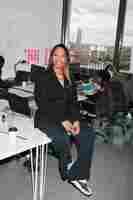Beautystack’s Sharmadean Reid helps you kickstart a community-focused brand
Did you know Sharmadean Reid is speaking at TNW2020 this year? Check out their session on ‘Business by women, for women’ here .

Sharmadean Reid defines herself as a “very philosophical and strategic entrepreneur,” someone who is able to look at the details and visualize a project from start to finish.
“I’m the type of entrepreneur who likes to have a thesis behind everything I do, and then build the right team around me to execute it,” she tells Growth Quarters.
It seems this strategy has so far paid off. Known in UK tech circles as the woman responsible for fixing beauty tech , Reid is the founder of BeautyStack , an online booking service that highlights the work of individual artists and creators.
She set up the business after founding WAH Nails — a nail salon business she opened in London’s Soho — which closed down following several years of trading .
Reid’s close ties with technology aren’t new either. While at university, she created a hip hop fanzine called ‘WAH,’ using her Mac Mini and after teaching herself how to use Adobe Photoshop and InDesign.
She’s long experimented with beauty and emerging new technologies, such as a VR Nail Design app, and is firmly on a mission to use tech to empower women — economically, socially, and culturally.
Reid’s tried and tested productivity hacks
For all intents and purposes, Reid is the kind of entrepreneur we all need in 2020. She’s constantly innovating and able to re-invent herself and her businesses based on consumer and market needs — but how exactly does she manage to do this over and over again?
It’s mostly down to compartmentalization, she says.
“I like to chunk up my time […] I try not to do any external meetings on Mondays or Fridays,” adds Reid, explaining how switching from one task to the next can cause her ( and you ) to lose 25 minutes at a time.
Other productivity hacks that work well for her include setting up a morning call with her team, taking frequent breaks, and clearing her inbox once a month.
As far as her creative process goes, Reid insists it isn’t structured, instead she makes a concerted effort to observe what is happening in her industry, and subsequently enters full-on research mode.
“I do a whole bunch of research into macro trends but I also listen to users,” she notes.
Creativity without structure
One of the hardest things about being a serial entrepreneur is coming up with ideas that help to solve real-world problems — and inspiration isn’t always easy to come by.
Reid says she gets her best ideas while she’s out walking. “I then call my smartest friends and tell them what I’m thinking and stress test my thoughts on them. I then wait to see whether they are receptive or if they’ve got any push back and think my idea is stupid,” she adds.
While some entrepreneurs swear by note-taking, Reid prefers to keep everything in her head.
She says she’s the type of “annoying creative” who wouldn’t have had a sketchbook to show off at art school — instead opting for thinking about what’s actually required and building it then and there.
This approach, she adds, has changed somewhat over the years, after acknowledging that she doesn’t always have the right answers or solutions.


Her experience has taught her that relying on her team and taking their expertise and insight on board is always a good idea .
To get this point across, Reid uses a party planning analogy: “Imagine I tell them that we’re going to have a party with 30 silver balloons … They may come back to me and say, well, the silver balloons are more expensive so we’ve decided to go for purple or black.”
Laissez faire — but be clear
This may seem like a straightforward decision to make, particularly if it helps to stay within budget, but it’s actually about much more than that.
It’s a concerted effort to let employees work autonomously and to refrain from micromanaging — a notion that many entrepreneurs, founders, and managers struggle with all too often.
“If I start micromanaging it’s because I’m concerned that my vision isn’t going to be fulfilled,” Reid says, attributing this to poor communication on her part.
“I’m of the view that if this happens it’s because I haven’t communicated my vision properly. So I try to clarify what I’ve said as opposed to actually micromanaging,” she explains.
This isn’t necessarily an easy thing to do, particularly now that many teams are working remotely and much of the nuance we have in face-to-face interactions is lost.
It’s therefore crucial that this clarification doesn’t come across like micromanaging. You need to be cautious and make it clear that you’re simply trying to articulate your vision more clearly to make it easier for everyone involved.
Reid is a firm believer in compassionate leadership — and says that the best advice she’s ever been given is to “know who to kick and who to hug.”
Building communities, not just brands
The brands she’s created are intrinsically tied with the notion of community, but building audiences hasn’t always been straight-forward.
“I think it’s really about identifying who the gatekeepers are and trying to unlock the various factions of the community you want to access,” Reid says.
Once again, Reid uses an analogy, this time resorting to a school canteen.
“Every single table at the school has a different crew or posse,” she begins, adding “You have the jocks, the popular girls, and music students. There’s someone on every table that’s going to be the person and ask you to pull up a chair and sit with them.”
The key here, she adds, is figuring out who that person is. Once you do, you’ll be able to access all the other people sitting at that table.
“I don’t go for scale in these early days because it’d be pointless to try and get all 10 people when you haven’t been co-signed by anyone and your message isn’t aligned,” she concludes.
All in all, success is what may keep Reid going, but her learnings are undoubtedly what have made her into the entrepreneur and business leader she is today.
If you too want to be productive and reach your goals, remember to:
Compartmentalize your time.
Take frequent breaks to keep focused.
Make a point of clearing your Inbox on the same day every month.
Be a compassionate leader but be firm when needed.
Take matters into your own hands. Do something that inspires you and stress-test your ideas with your network.
Build communities takes time. Figure out who the gatekeepers are and focus on quality, not quantity.
So you like our media brand Growth Quarters ? You should join our Growth Quarters event track at TNW2020 , where you’ll hear how the most successful founders kickstarted and grew their companies.
I work 5 hours a day, and I’ve never been more productive
Something’s very wrong with the traditional 9 to 5: it doesn’t work.

Scandinavian countries dominate the World Happiness Report — Norway being the third most productive country in the world and Helsinki winning the title of the best city for work-life balance . And their standard working week is less than 40 hours long. They work a whopping 359 hours less than Americans every year.
How I began working 5-hour workdays (by accident)
When I quit my job in the great resignation of 2020 to become a freelance writer, I was determined to continue working eight-hour days. I was a “real” full-time writer, after all, and I needed to prove it by working just like everyone else works.
That is, until I couldn’t.
I contracted COVID-19 in May 2021. After coming back to work in June, I began to notice my focus and energy falter. The doctor told me it was brain fog — a common side-effect seen in those who’ve recovered from the virus. I knew I might have to take it down a notch for a few months.
On most days, I couldn’t work beyond five hours. But surprisingly, my productivity didn’t budge with the reduction in working hours: I earned the same income, met deadlines comfortably, and left the desk fulfilled. My clients were just as happy as before.
But was my skyrocketed productivity just the result of the rest I had to take while recovering? I was skeptical. I decided to continue the shorter workday, despite fully recovering in July. And I’m never going back to the eight-hour workday again.
8-hour vs. 5-hour workdays
I work in Pomodoros for everything — from writing to responding to emails to networking. I track how many hours I work, what I work on, and how much time I take to finish a task using the Pomofocus timer and the data it provides.
Before, I worked eight or nine hours a day. But I hardly attributed my burnout and lack of creative satisfaction to overworking. “Maybe I haven’t rested enough, planned well, or learned enough productivity techniques,” I thought.
It wasn’t uncommon for me to end days thinking, “if only I had more time” — because I always had some items unchecked on my to-do list.
Now, when I’m working only five hours a day, I notice I cross off almost all my tasks. Knowing I only get five hours has made me more intentional with my to-do list: I assign priorities better, say no more, and sign up only for the necessary meetings.
I’m working smarter, not harder. The same tasks also visibly take less time to complete now. I can write a well-researched 2,000-3,000 word article in half the time, which gives me more time to grow my business.
My relationship with work shifted. Having only five hours forced me to say yes to only exciting freelance writing jobs that would also pay well. And instead of working till 1 a I started to ask for more lenient deadlines (and my clients happily agreed).
Nothing is as urgent as it seems.
Leading a fuller life outside of work—having hobbies, socializing, going for long walks, playing the violin — further boosted my creativity and mental well-being. With more idle time and fewer hours chained to the chair, I could make space for personal passion projects like improving my newsletter (check it out here ), working on my website ( here ), and laying the groundwork for my podcast.
But it wasn’t easy. I often felt like I could do more, made unrealistic to-do lists, and struggled to challenge my mindset about working. I’d like to share a few things that helped me, in case you’re starting to think about experimenting with the five-hour workday too.
The mindset shift
The biggest barrier for me wasn’t managing tasks well in the limited five hours — it was convincing my brain that there’s no correlation between the number of hours I work and how productive I am.
I can’t overstate the importance of changing your mindset first — before you worry about the practical concerns. 81% of people spend less than three hours a day on creative work anyway.
I suggest doing a time-tracking experiment to see how many hours you work in a day and how many of those are productive. You’ll likely notice that after a certain number of hours, sitting any more just gets you diminishing returns. That’s when you know you should stop working for the day.
Work in your mental peaks
There’s a time of the day you work better. Maybe it’s in the morning before your kids are awake, maybe it’s late at night with no distractions, or maybe it’s in the afternoon lull. You tend to do your best work in these hours and get more done in less time. It’s your best time to focus.
For me, the flow state is easier to grab in the mornings. I make a conscious effort not to schedule any meetings or personal appointments during these early hours to get maximum done.
You can find these mental peaks through trial and error or by using a time tracking app. Once you know your best hours, you should optimize your day according to them — manage your energy, not your time. (Here’s a guide from Zapier on how to find your chronotype and schedule your productivity .)
Prioritize and value rest
When you carry your office with you everywhere, you need to be disciplined about rest. In his book, Rest: Why you get more done when you work less , Alex Soojung-Kim Pang talks about the importance of downtime and emphasizes why work and rest are not opposites but complementary.
He broke down the schedules of highly successful people from various industries — from scientists to artists — and found a similar schedule: work intensively for four to five hours, and spend an equal amount of time on deliberate rest.
For people with less control over their workdays, like doctors and executives, Pang suggests taking long vacations without technology or using the weekends to engage in enjoyable activities that are also a little physically and mentally challenging.


I set a hard deadline for myself to get up from my desk at 5 and not check email on the weekends. It gives me enough space to rest physically and mentally, unplug a little, and return to work more refreshed.
Plan your workday intentionally — and realistically
When I started to notice the increase in productivity, I began challenging myself to do more and more in those five hours. I let unnecessary tasks seep into my to-do list and set unrealistic expectations for myself — which not only affected my mental health but also compromised my quality of work.
I quickly realized I was setting myself up for failure. I knew I valued quality over quantity, so I got picky. I’d limit my to-do list to three items, estimate how long they would take me to finish, and add an hour of buffer time.
Here are my three golden tips for realistic planning:
Underestimate how much you can get done in a day
Overestimate how much time a task will take
Overestimate interruptions during your day
You don’t need to complicate it. Go easy on yourself, and make it a point to be more mindful while making your to-do list.
Five hours is enough (sometimes, it’s more than enough)
Personally, my life turned upside down after implementing the five-hour workday. My mental health has never been better, and I’ve never gotten so much done at the same time. Now, my days have room for spontaneity, daydreaming, and boredom.
If you’re just getting started with working fewer hours, I suggest taking it slow and customizing the suggestions in this article according to your life. It’s better to build a routine that works for you by experimenting rather than going around searching for the perfect system that you can’t stick with.
How many hours we work per day is a question that barely holds any importance today. It’s time to ask better questions: how can you find more time to think? How can you minimize distractions? How can you manage your energy well? These are the questions we should all be focusing on instead.
This article by Rochi Zalani was originally published on the Zapier blog and is republished here with permission. You can read the original article here .
Startups vs established companies: 4 biggest differences for marketers
What are the major differences in doing marketing for startups compared to mature companies? Over the past few years, this question has puzzled me… and, it turns out, many of my colleagues.

But now that I’ve been on the two diametrically opposite sides of the marketing universe — conceptualizing omnichannel campaigns in mature companies and analyzing promotional mechanics in early-stage startups — I’ve had the opportunity to compare them and figure out exactly where the difference lies.
So if you’re interested in knowing the answer, check out the quick summary of my findings below where I highlight the most striking differences in addition to sharing the lessons I learned along the way.
1. Embrace uncertainty in the early days
Developing, planning, and executing large-scale marketing projects in established companies usually require setting well-defined goals that the marketing team is expected to achieve.
Participating in such projects, specialists typically have a system in place to acknowledge, plan, and measure the goals and outcomes of their marketing activities.
For a startup, especially one in the early stages, the situation is completely different. At its heart, entrepreneurship is not about sticking to pre-written guidelines but instead about inventing novel solutions.
Uncertainty is a distinguishing trait of early-stage companies in not only marketing endeavors but also everyday operations, so setting such detailed goals for startups is challenging. As we all know, every startup is unique, and the road to good results is paved with unexpected twists and turns.
Nevertheless, a startup founder should outline at least the minimum range of key objectives of a promotional campaign. It’s necessary to picture what the marketer should be working on, after all. Having a direction to move forward gives a chance to speed up the process without busting an advertising budget.
2. Continue experimenting on the fly
As startups operate under a high level of unpredictability, they test various promotional channels, growth hacking mechanics, and advertising initiatives more often and to a greater degree than mature companies.
When I worked for an established business-to-consumer company, I started preparing marketing campaigns weeks and even months before their actual launch. The process involved profound analysis and planning filled with a series of focus group discussions, in-depth interviews, and hours of research by account planners, among other things.
This approach reduced the need for numerous experiments at the start and entire duration of the campaign. Still, it is different from the startup world, where companies might be born and miraculously flame out within the time span that it took to launch one advertising campaign in a large corporation.
Unlike a mature company, a startup has more unknown variables to consider and the higher probability that the final result may not be the one initially expected. Adapting to changing circumstances under intense time pressure, startups need to keep experimenting and stay resilient to complications until they find the best-performing solutions.
I came across an illuminating example of this in one early-stage startup, which struggled to build a strong lead generation process. It tried multiple conversion and distribution tactics until a startup founder heard about a few effective advertising methods and called a performance marketer.
A few hours later, a campaign was up and running on their social media channels. Based on what the startup team learned from gathering and analyzing the campaign results in two days, it identified many ways to gain swift attention from potential customers and put sales on a steady upward trajectory.
3. Acknowledge the proximity to the problem and its solution
For the most part, early-stage startups have small teams, often with one person wearing multiple hats by participating in a number of cross-functional projects outside of their initial job description. This situation represents a blend of advantages and disadvantages.
One advantage is that startup employees can explore different aspects of business by rolling up their sleeves to support project execution. This turns such employees into more well-rounded specialists with hands-on experience.
Of course, large companies provide great opportunities for professional development, creating a learning culture. An example would be rotational management programs in different corporate departments. However, the participants of such programs often have more specialized responsibilities as compared with that in startups.
Another positive aspect of joining a startup is that marketers can better understand the market, consumers, and the core consumers’ problems the company tries to solve with the help of its product.
While conducting market research in-house, for instance, a specialist can uncover earlier insights about consumer needs and tailor the product offering to address these needs straight away.
Enterprise software-as-a-service (SaaS) solutions with their advanced features and customization options are a brilliant illustration of meeting customer demand in a more targeted and agile way.
In the context of disadvantage to this proximity to the problem and its solution, if a startup employee stumbles upon barriers when trying to do a certain task and does not have more knowledgeable colleagues to ask for guidance, this task might remain uncompleted.
4. Get to know the customers well
Generally speaking, a deep understanding of the target audience is important for different types of businesses. While mature companies might have many resources to invest in consumer research, startups can get a head start in some cases.
For instance, there are situations when founders can supercharge their startup growth by listening to and engaging with the representatives of their target audience early on.
I am not stating for one moment that established companies do not interact with consumers when they develop new products. I am merely saying that they usually adopt a more structural and prolonged approach.
Working on a project as part of the marketing team of a large company, I participated in focus groups to get a glimpse into the target audience’s preferences and needs. While the process from organizing the consumer research activities to getting the final results and recommendations from our market research agency was masterfully orchestrated, it took a couple of weeks.
Early-stage startup founders can obtain helpful information in a matter of hours by calling their first customers personally and asking their opinions.
In a direct-to-consumer startup, for example, marketers and founders might have the customer insights at their fingertips. They can immediately identify the best-selling products by looking at arrays of readily available data instead of collecting sales reports from business partners and retailers prior to the analysis.
Even though a startup might have limited resources, due to its proximity to customers and ability to get an answer fast, it is not necessarily in a worse position than industry heavyweights with substantial budgets for consumer research.
Entering the playing field, startups can get far ahead in the game by following a test-and-learn approach, constantly looking for growth opportunities, and listening to the customers’ voices.